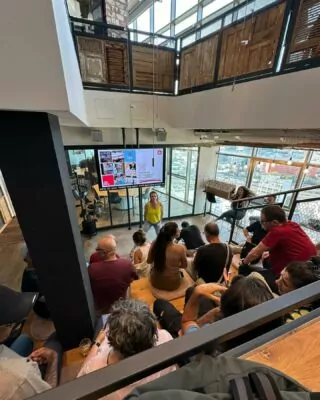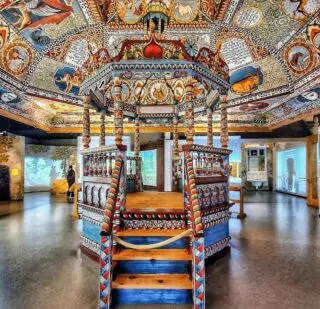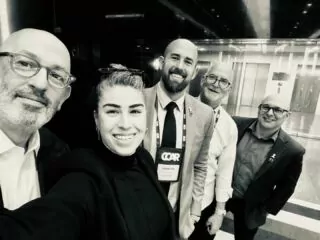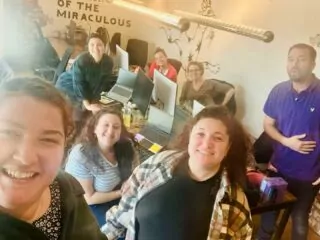- Jewish timeline
- General timeline
EARLY HISTORY
- 300 000 Neanderthal presence in the area
1000 Indo-European Illyrians migrate into region
500 Illyrians dominate while Greeks establish trade on Adriatic coast
11 Rome rules most of present-day Croatia. Create network of trade & towns
- Jews settle in Roman towns, including in Savona (near modern-day Split)
- 600 Croats and other Slavic tribes arrive from today’s Ukraine, Poland, and Belarus
Under threat from Croats, walled city of Split becomes Roman stronghold
The walled city of Dubrovnik (Ragusa) also established on Adriatic Coast
- Limited evidence suggests small Jewish communities active, including in Split
- 800 Croats begin accepting Christianity, strengthening collective identity
925 Kingdom of Croatia established but independence and stability fragile - Little is known about extent, if any, of Jewish population in this period
A CROSSROADS OF EMPIRES, FAITHS, ETHNIC GROUPS
- 1100 Venice and Italian elites control most of southern coast for next 700 years
Northern Croatia under Hungarian rule. Town of Zagreb grows in importance
- Jewish communities settle in Zagreb and elsewhere in northern Croatia
1402 Synagogue built in Dubrovnik (independent city-state on southern coast)
1456 Jews expelled from Hungarian-controlled northern Croatia
- 1493 Ottoman Empire conquers Bosnia and Serbia, makes inroads into Croatia
1526 Northern Croatia (and Hungary) absorbed into Habsburg (Austrian) Empire
- No Jews in north Croatia, Sephardi immigration boosts south coast communities
Sephardi immigrants play important role in southern maritime trade
1537 Cemetery in Split (one of oldest still used today) established
- 1600 Much of northern Croatia now under Ottomans Turks except around Zagreb
Serbian Orthodox settlers come to Krajina to help under-siege Habsburgs
Krajina becomes a key area for the substantial Serbian minority in Croatia
1683 Ottomans defeated. Habsburgs regain control of northern Croatia
Period of stability brings many immigrants from different groups
1738 Living conditions on southern coast declining greatly
- Jews in previously tolerant southern coast (Split, Dubrovnik) confined to ghetto
1773 25 Jewish families in Austrian-ruled northern Croatia, est. 600 Jews in south
1782 Austrian Emperor grants religious freedom to Jews
1806 Jewish immigration (Ashkenazi) increases, main settlement Osijek in northeast
NATIONALISM ON THE RISE
- 1815 Austrian Empire gains control of south coast
Austrian Empire allows Hungary to rule north Croatia
Hungary tries to impose language and culture on north Croatian population
1848 Croatians fail to overthrow Hungarian control in north and east
Croatian nationalist efforts strengthen but split into two camps
Some favor unity with Serbia in autonomous South Slavic entity (Yugoslavia)
Others favor Croatian independence and oppose alliance with Serbia
1857 Croatia pop. 2.1 million and growing. Economy based on agriculture
- 1870 Population grows. 10,000 Jews in Croatia, mainly merchants and artisans
- 1900 Croatia remains a poor, overwhelmingly rural, society with low literacy levels
Extreme poverty on southern coast sparks large-scale migration
- 20,000 Jews in 33 communities. Zagreb is and will remain largest community
Most Jews in north. They are mainly middle-class, urban, Ashkenazi
They are influenced by German and Hungarian culture, Reform movement
Southern Jews mainly Sephardi. Active in trade, religious, and secular culture
CROATIA AS PART OF THE KINGDOM OF YUGOLSAVIA
- 1914 Nationalism grows among Croats, Serbs, and Austro-Hungarian Empire
Serb assassination of Austrian Archduke in Sarajevo, Bosnia sparks World War I
1918 Austro-Hungarian Empire collapses following defeat in WWI
Fearful of Italian and Hungarian intentions, Croats join Kingdom of Yugoslavia
A diverse, multicultural kingdom of 12 million with all men able to vote
Serbs (mainly Orthodox Christians) 38% of population
Croats (mainly Catholic) 24%, Bosnian Muslims 6%. Many other groups
Kingdom based in Belgrade, Serbia. Heavy Serbian influence in politics, army
- 65,000 Jews in Yugoslavia, 100 communities with considerable diversity
Some Croatian anti-Semitism but Jews generally accepted in Yugoslav kingdom
- 1920 Croatian peasant revolt a sign of wider ideological and national tensions
1928 Serbian politician assassinates Croat leaders in Yugoslav parliament
Fearing civil war, King Alexander declares royal dictatorship
Ante Pavelic establishes Ustaŝe, a Croatian separatist, anti-Serb terror group
Ustaŝe seek independent, fascist-Catholic Croatia including in all of Bosnia
1934 Ustaŝe and Macedonian nationalists assassinate King Alexander
A MURDEROUS WORLD WAR II
- 1941 Axis nations (Germany, Hungary, Italy, Bulgaria) occupy and divide Yugoslavia
Germans establish puppet state of Croatia (includes north Croatia, Bosnia)
Is ruled by the Ustaŝe. They decimate political opponents & non-ethnic Croats
Jasenovac concentration camp system established by the Ustaŝe
- Ustaŝe kill 340,000 Croatian Serbs. Roma population of 27,000 devastated
Ustaŝe kill most Croat Jews, many at Jasenovac
Others handed to Germans and deported to Auschwitz
Southern Croatia under Italian rule; only place of protection for Yugoslav Jews
- 1945 Communist partisans led by Josip Tito (a Croat) liberate Yugoslavia
One in eight Yugoslavs (mainly civilians) killed in war, one of highest ratios in Europe
- 67,000 Yugoslav Jews (including over 30,000 in Croatia) killed; 14,000 survive
CROATIA AS PART OF COMMUNIST YUGOSLAVIA
- 1945 Yugoslavia is the only Communist state without direct Soviet control
One of Europe’s poorest, most multi-national states. Mainly rural, religious
Pop. 15.7 million including 6.5 million ethnic Serbs, 3.8 million ethnic Croats
Tito launches “ultra-Bolshevik” economic and political program
Executes opponents, including Croatian fascists and Catholic leaders
1946 Federal Yugoslavia has 6 republics including Croatia, Bosnia, and Slovenia
Serbia largest republic but Tito prevents nationalist conflict & Serb dominance
- Yugoslav Jews (with JDC help) re-establish communities including in Croatia
- 1948 Soviets break with Yugoslavia: Stalin condemns ambitious, independent Tito
- 8,000 Yugoslav Jews leave for Israel in next four years. Just 6,500 remain
- 1949 Fearing economic collapse & Soviet invasion, Tito accepts huge US financial help
He keeps political control but finishes purges & allows more economic flexibility
1960 Socio-economic improvements; “repressive but not oppressive” political system
- 1967 Govt. breaks with Israel but local Jews retain communal and religious freedoms
- 1968 Economy boosted by Yugoslav “guest workers” in booming Western Europe
1970 Zagreb’s population has doubled to 560,000 over last 20 years
Croatian Spring: Zagreb students demand more liberties and Croatian autonomy
1974 Keeping the peace: new constitution gives greater rights to Croatia
Yugoslavia a land of overlapping minorities. Each republic has multiple groups
A more secular, integrated Yugoslavia emerging, especially in growing cities
Both Serbs & Croats speak Serbo-Croat (different alphabets but similar verbally)
1975 Croatian-Swiss scientist Vladimir Prelog wins Nobel Prize in Chemistry
1980 Tito dies. Presidency rotated among leaders of 6 republics to maintain balance
Northern republics of Slovenia and Croatia wealthier than others
They are concerned by federal govt. economic policies and its massive debts
- 5,500 Jews in Yugoslavia (2,000 in Croatia), increasingly secular communities
- 1989 Communist control weakening like in much of Eastern Europe
Croatia worried by Serbian nationalist leaders including Slobodan Milošević
1990 Yugoslav inflation (1240% per year) another factor in Croatian separatism
Croatian republic elect anti-Serbian nationalist Franjo Tudjman
This in turn alarms the 560,000 Serbs living in Croatia, 12% of total population
- Tudjman also makes anti-Semitic, anti-Muslim remarks
WAR & ETHNIC CLEANSING RETURN TO EUROPE
- 1991 Both Croatia & Slovenia declare independence from Yugoslavia
Germany & European community quickly recognize these new sovereign states
Serb-dominated Yugoslav army launches attacks on these “rebel republics”
Over next 8 years, there will be 5 main Yugoslav wars. Three involve Croatia
New Croatian state at war with its Serb minority (backed by Serbia-Yugoslavia)
Massacres, ethnic cleansing, many Croats displaced by Serbian forces
- Jewish community buildings in Zagreb and Dubrovnik damaged in bombings
- 1992 Fragile ceasefire declared in Croatia. Serbs hold part of Croatia (Krajina)
Bosnia (led by local Muslims & Croats) declares independence from Yugoslavia
War in Bosnia. Bosnian Serbs versus local Muslims & Croats (backed by Zagreb)
1993 Bosnian Croats seek to establish own state (Herzegovina) & link it to Croatia
Croatia & Bosnian Croats now at war with Bosnian Muslims & Bosnian Serbs
War in Croatia breaks out again. Croatia eventually recaptures Serb-held Krajina
Estimated 200,000 ethnic Serbs flee or are expelled from Croatia
1995 Croatia wins its war of independence. Dayton agreement ends Bosnian conflict.
1999 Last Yugoslav war (in Serbian province of Kosovo) ends after NATO bomb Serbs
In all of former Yugoslavia, estimated 140,000 dead (20,000 killed in Croatia)
Over 2 million refugees & displaced people after widespread ethnic cleansing
Worst European violence since WWII. Multinational communities destroyed
A NEW NATION, A NEW BEGINNING?
- 2000 New, more moderate leadership: Tudjman dies, Milošević overthrown in Serbia
Increased democracy in Croatia & a fast-growing economy
- Estimated 1,700 Jews in Croatia, mainly Zagreb
- 2005 Tourism boom: Lonely Planet calls Croatia world’s best spot to visit
2007 Income has doubled in Croatia since end of war
2008 Global financial crisis hits Croatia hard. Public spending slashed
2012 Croatia education system voted 22nd in world (equal with Austria)
2013 Croatia joins EU. Economy recovering somewhat but 17% unemployment
Most Serb refugees do not return. Croatia now 90% Croat, just 4% Serb
2015 Over 700,000 refugees from Syria and elsewhere pass through Croatia - Croatian President visits Israel; condemns Ustaŝe’s role in Holocaust
However, Croatian Jewish leaders condemn increasing Holocaust revisionism
- 2018 A small nation, a soccer giant. Croatia reaches final of World Cup
2019 Population of Croatia: 4.1 million
Jewish population: 1,700
J2 STUFF.
We have everything you need to know before you go. Check out our Instagram my_j2adventures for cool updates and interesting tidbits.
The J2 App
available on the App Store & on Google Play.

START PLANNING LET’S EXPLORE.
Whether you have a journey in mind, want to join a featured trip, or simply want to explore, drop us a note. We work really hard to be a loved travel company that delivers amazing and memorable experiences. So please do not be surprised when we say “yes” to every reasonable request you make!













